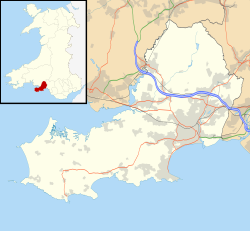City and County of Swansea
|
Swansea Abertawe City and County of Swansea Dinas a Sir Abertawe |
|
|---|---|
| City & County | |
 |
|
| Motto: Floreat Swansea | |
 City and County of Swansea and (inset) within Wales |
|
| Sovereign state | United Kingdom |
| Country | Wales |
| Ceremonial county | West Glamorgan |
| Historic county | Glamorganshire |
| Admin HQ | Swansea Guildhall |
| Town charter | 1158–1184 |
| City status | 1969 |
| Government | |
| • Type | Principal area, City |
| • Leader of Swansea Council | Rob Stewart |
| • Welsh Assembly and UK Parliament Constituencies | |
| • European Parliament | Wales |
| • MPs |
|
| • AMs |
|
| Area | |
| • Total | 150 sq mi (380 km2) |
| Population (2011) | |
| • Total |
|
| • Density | 1,560/sq mi (601/km2) |
| • Ethnicity |
|
| Time zone | GMT (UTC0) |
| • Summer (DST) | BST (UTC+1) |
| Post codes | SA1-SA7 |
| Area code(s) | 01792 |
| Vehicle area codes | CP, CR, CS, CT, CU, CV |
| OS grid reference | SS6593 |
| NUTS 3 | UKL18 |
| Police Force | South Wales Police |
| Fire Service | Mid and West Wales Fire and Rescue Service |
| Ambulance Service | Welsh Ambulance Service |
| Website | www.swansea.gov.uk |
Swansea (/ˈswɒnzi/ SWON-zee; Welsh: Abertawe [abɛrˈtawɛ]), officially known as the City and County of Swansea (Dinas a Sir Abertawe), is a coastal city and county in Wales. It is the second largest city in Wales after Cardiff, and the twenty-fifth largest city in the UK. Swansea lies within the historic county boundaries of Glamorgan and the ancient Welsh commote of Gŵyr. Situated on the sandy South West Wales coast, the county area includes the Gower Peninsula and the Lliw uplands. According to its local council, the City and County of Swansea had a population of 241,300 in 2014. The last official census stated that the city, metropolitan and urban areas combined concluded to be a total of 462,000 in 2011, making it the second most populous local authority area in Wales after Cardiff. During its 19th-century industrial heyday, Swansea was a key centre of the copper industry, earning the nickname 'Copperopolis'.
Archaeological finds are mostly confined to the Gower Peninsula, and include items from the Stone Age, Bronze Age, and Iron Age. The Romans reached the area, as did the Norsemen.
...
Wikipedia
